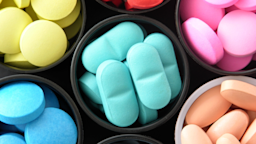Key takeaways:
Methamphetamine (meth) is a very addictive stimulant. It affects someone’s thoughts, feelings, and behaviors.
Helping a person with a meth addiction can be hard if they’re not ready for help. Try to educate yourself, and share your concerns calmly and without judgment. And make sure to care for your own needs too.
Professional treatment is available to help people recover.
Methamphetamine (meth) is a powerful and addictive substance, no matter how it’s consumed. For many, casual use can lead to misuse. About 1.8 million people in the U.S. have a methamphetamine use disorder. Meth addiction can greatly affect a person’s life. And it impacts people around them as well — including family and friends.
Addressing someone’s meth use disorder can be challenging. You want to help them recover without damaging your relationship or compromising your own boundaries and self-care. Consider these steps to help someone experiencing meth addiction.
1. Learn about the condition
Substance use disorders and other mental health issues can affect many aspects of a person’s life, including their physical and mental health, relationships, and finances. A person experiencing addiction may try to hide their symptoms, but some signs will be apparent.
Methamphetamine is a stimulant, which means that it increases activity in the brain. When a person is under the influence of meth, they may display:
Euphoria
Increased energy
Talkativeness
Not everyone who uses meth will have a meth addiction. An addiction is when a person continues to use a substance like meth despite serious consequences. Knowing the signs of an addiction can help you recognize it — and recognition is an important step toward getting someone help.
Here are some warning signs of meth addiction:
Neglecting responsibilities
Showing energy and sleep pattern changes
Increasing time and effort spent on meth use
Withdrawing from friends and activities they previously enjoyed
Continuing to use meth despite negative consequences
Lying or being secretive
Additionally, a person who uses meth for a long period of time may show physical signs of use, including:
Weight loss
Skin sores
Tooth loss
Methamphetamine overdose: Learn how to recognize the signs of a meth overdose and what to do during this life-threatening emergency.
Preventing overdose deaths: Meth overdoses often involve opioids. Narcan is a lifesaving medication that can reverse the effects. Learn how to get it at no cost.
Symptoms of meth addiction: Meth is a very addictive stimulant that can cause dangerous signs and symptoms, including hallucinations and paranoia.
Good to know: Meth use can lead to overdose. A meth overdose is a medical emergency and needs immediate medical attention in a hospital. Call 911 if you think someone is experiencing an overdose.
2. Decide if you will address someone’s addiction
Now that you know what to look for, you can begin gathering some more information. Write down the changes you notice and when you notice them — and how this makes you feel.
Also, consider your role in your loved one’s life and your relationship to their substance use. Are you a partner, friend, or family member? Do you have a difficult history with substance use that would affect your ability to offer support?
Based on this information and your reflections, you may choose to move forward with helping them because their behavior has you concerned and you feel able to provide support.
Read more like this
Explore these related articles, suggested for readers like you.
Connecting with other people who have a loved one with addiction or attending support groups can also help you reflect on your loved one’s situation and how to move forward (more information below). They may be able to give you advice, resources, and support, since they understand what you’re going through.
3. Start the conversation
If you’ve decided to talk with your loved one, plan how you will start the conversation. Clear and direct communication is the cornerstone of strong relationships and getting someone help.
Keep in mind that you don’t need to cover everything in one conversation. So be patient and plan to have at least a few talks.
Here are some ways to make the communication as effective as possible:
Schedule a time and place to talk. Let your loved one know you’d like to talk to them, and set a time and location. Choose a time when you have plenty of time to talk. Find a place that’s quiet and relatively private.
Make sure they’re sober and attentive. If your loved one is under the influence or distracted, there’s little chance they’ll fully remember the talk. Do your best to create a setting that’s calm and free from distractions.
Make a plan. Outline key points you’d like to emphasize, and think about what you’d like to achieve with the conversation. Without a plan, your conversation might not meet your intended purpose.
Prepare for their reactions. Will your loved one react with acceptance and gratitude, or anger and denial? Thinking through how they may respond gives you the chance to plan your reactions before they arise. Remember that these conversations can be difficult for everyone.
Be direct and get to the point. Start the conversation with something like, “I’m worried you’re using again,” and back it up with facts.
Ask questions, and listen to the answers. Your loved one probably isn’t interested in a lecture. Ask them plenty of questions about their experience, feelings, and fears. Remember that they’re struggling. Listen to their responses, stay calm, and remain empathic and understanding.
Try to avoid:
Blaming them
Being disrespectful, rude, or condescending
Becoming too negative or pessimistic
Allowing high levels of emotion to get in the way of your listening
It may take many conversations until your loved one is ready to face their meth misuse. Change is a process that takes time.
4. Make yourself a priority
When you spend a lot of time and energy supporting someone else, it can be easy to neglect your own physical and emotional needs. So, be sure that you’re taking care of yourself too. You may not feel like you have enough energy or motivation. But it’ll be much harder to help someone experiencing meth addiction if you’re overwhelmed and struggling.
Self-care includes eating well, getting enough rest, and making time for physical activity and hobbies you enjoy. Find ways to do things you like with people you love.
It may also help to speak with a therapist who has experience working with addiction in families. Therapy can provide a safe space for you to express yourself and learn ways to cope.
You can also consider getting connected to a support group. These groups can offer another level of care. Some options include:
Nar-Anon Family Groups: These are support groups for loved ones affected by drug use.
SMART Family and Friends: These groups also offer a safe space for people to learn how to cope with their loved one’s addiction.
National Alliance on Mental Illness (NAMI) Family-to-Family: NAMI Family-to-Family is a free educational program for family and friends of people with different mental health conditions.
NAMI Family Support Group: NAMI Family Support Group is a free support program that’s led by people who’ve faced similar experiences.
How do I support someone who has a meth addiction?
Meth use disorder can be intense and scary. You might feel like your loved one becomes a completely different person when they use. And you may worry that you can’t help them.
Here are some things to keep in mind as you support someone with a meth use disorder:
Suggest treatment options. Substance use treatment centers can best manage methamphetamine addiction. Research available options in your area and let your loved one know about them. Offer to help schedule an appointment or take them to one.
Stay consistent. If you’re very encouraging one day and then frustrated and angry the next, your friend might disengage. Try to regulate your feelings and maintain an upbeat, optimistic approach. At the same time, remember that your feelings are valid. Seek your own support to process your emotions.
Try not to enable their use. Avoid lying or making excuses for your friend. This type of enabling behavior may unintentionally encourage continued use because it can shield them from the consequences of their actions. If they have problems from meth, allow the consequences to unfold naturally.
Protect them and yourself. Meth can make people act out in ways that may put them in dangerous situations. If you ever see your friend threaten themselves or another, call 911 immediately.
How is meth addiction treated?
In some cases, people may need a medical detox as the first step in methamphetamine treatment. Medical detox is designed to safely manage the physical effects of withdrawal when someone stops using meth. Many people have trouble focusing on their recovery if they’re still dealing with withdrawal.
After that, individual and group therapy are the main ways to treat a meth addiction. Some effective treatments for meth use disorder include:
Cognitive behavioral therapy (CBT): CBT is a type of psychotherapy that helps people understand the connection between their thoughts, feelings, and behaviors. CBT also teaches coping skills.
Motivational interviewing: This is a framework that helps guide a conversation about making change. You work with a therapist to match your actions to your recovery goals.
Contingency management: This is a type of therapy that provides rewards for completing recovery-focused behaviors, like maintaining abstinence.
Community reinforcement: This treatment uses the influence of friends, family, and community members to maintain recovery.
The Matrix model is also helpful for stimulant addiction. This 16-week behavioral treatment program offers a combination of:
Twelve-step support
Individual and group therapy
Family education
Toxicology testing
It also encourages people to get involved in positive activities that don’t involve substances.
Family therapy can be an important part of addiction recovery as well. You may have opportunities to support your loved one’s recovery by participating in family therapy.
There are no FDA-approved medications to treat meth use disorder. But some healthcare professionals may offer medications to address any other conditions, such as depression, anxiety, or schizophrenia.
Resources and support groups for meth addiction
Support groups aren’t professional treatment options. But they can help target addiction by meeting with others experiencing similar issues. Additional resources for someone dealing with meth use disorder may include support groups like:
Encourage your loved one to experiment with different options. Sometimes it takes trying a few things to find what works best. As a friend, you can even offer to attend a support group with them or help with transportation or childcare.
The bottom line
Meth is a powerful and addictive stimulant that affects people who use it as well as those around them. If you’re trying to help someone with a meth use disorder, try to express your concerns in a compassionate manner and listen to their struggles too. You can also encourage them to seek treatment and attend a support group.
Keep in mind that change doesn’t happen overnight. It may take several conversations or tries for a person with meth addiction to get help.

Why trust our experts?



References
Canadian Centre on Substance Use and Addiction. (2017). Community reinforcement approach.
Department of Mental Health and Substance Abuse Services. (n.d.). Warning signs of drug abuse.
National Alliance on Mental Illness. (n.d.). NAMI family-to-family.
National Alliance on Mental Illness. (n.d.). NAMI family support group.
National Center on Substance Abuse and Child Welfare. (n.d.). Strategies to support parents with methamphetamine use disorder and their families. Substance Abuse and Mental Health Services Administration.
National Institute on Drug Abuse. (n.d.). Communication (archive).
National Institute on Drug Abuse. (2011). Drug misuse and addiction.
National Institute on Drug Abuse. (2011). What are the long-term effects of methamphetamine abuse?
National Institute on Drug Abuse. (2011). What is methamphetamine?
National Institute on Drug Abuse. (2011). What treatments are effective for people who misuse methamphetamine?
Stoner, S. A. (2018). Effective treatments for methamphetamine use disorder: A review. University of Washington.
Substance Abuse and Mental Health Services Administration. (n.d.). Helping a loved one dealing with mental and/or substance use disorders.
Substance Abuse and Mental Health Services Administration. (n.d.). Supporting a loved one dealing with mental and/or substance use disorders.
Substance Abuse and Mental Health Services Administration. (2006). Intensive outpatient treatment approaches. Substance Abuse: Clinical Issues in Intensive Outpatient Treatment.
Substance Abuse and Mental Health Services Administration. (2020). Family counseling approaches. Substance Use Disorder Treatment and Family Therapy: Updated 2020.
Substance Abuse and Mental Health Services Administration. (2024). Key substance use and mental health indicators in the United States: Results from the 2023 National Survey on Drug Use and Health.
University of Pennsylvania Health System. (n.d.). Stairway to recovery.
U.S. Drug Enforcement Administration. (2020). Drug fact sheet: Methamphetamine.







